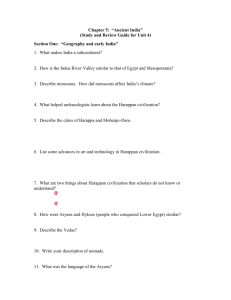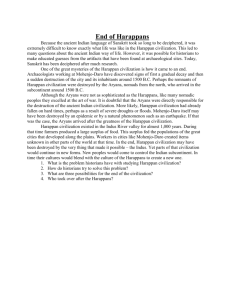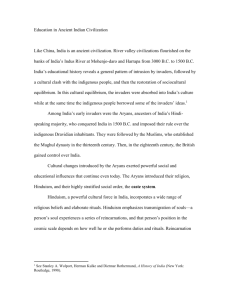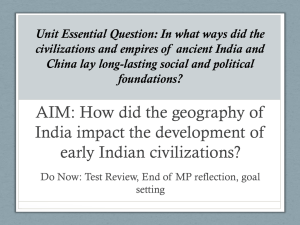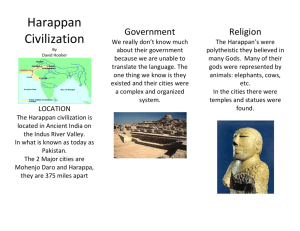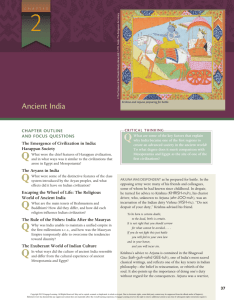Chap 2 Study Guide.doc
advertisement
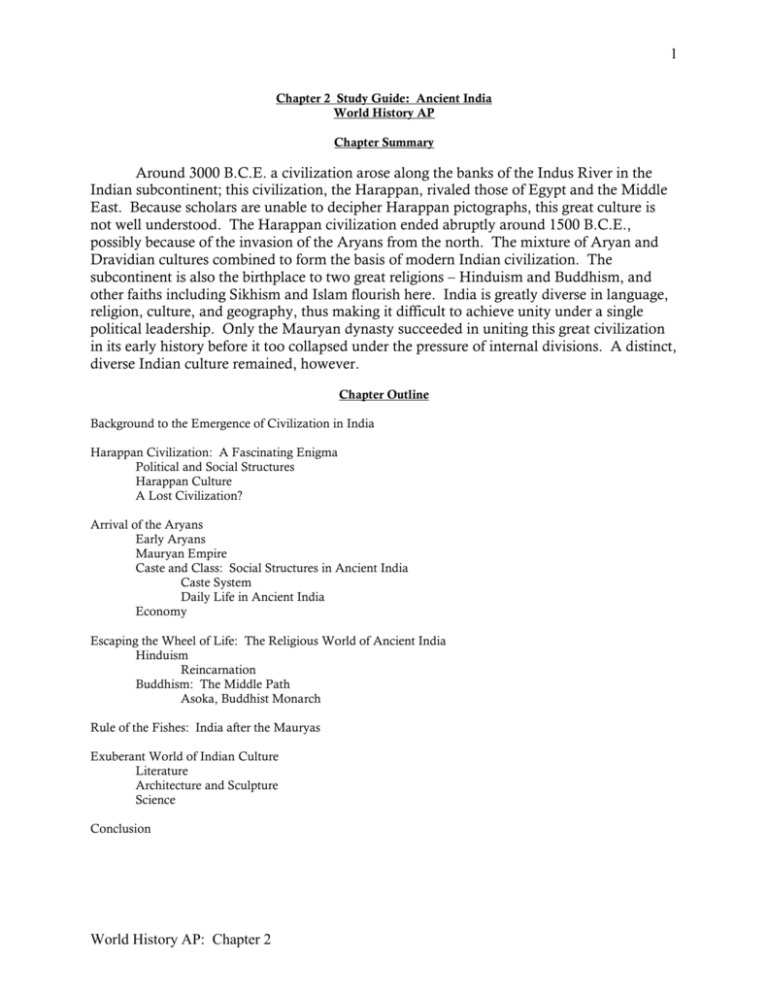
1 Chapter 2 Study Guide: Ancient India World History AP Chapter Summary Around 3000 B.C.E. a civilization arose along the banks of the Indus River in the Indian subcontinent; this civilization, the Harappan, rivaled those of Egypt and the Middle East. Because scholars are unable to decipher Harappan pictographs, this great culture is not well understood. The Harappan civilization ended abruptly around 1500 B.C.E., possibly because of the invasion of the Aryans from the north. The mixture of Aryan and Dravidian cultures combined to form the basis of modern Indian civilization. The subcontinent is also the birthplace to two great religions – Hinduism and Buddhism, and other faiths including Sikhism and Islam flourish here. India is greatly diverse in language, religion, culture, and geography, thus making it difficult to achieve unity under a single political leadership. Only the Mauryan dynasty succeeded in uniting this great civilization in its early history before it too collapsed under the pressure of internal divisions. A distinct, diverse Indian culture remained, however. Chapter Outline Background to the Emergence of Civilization in India Harappan Civilization: A Fascinating Enigma Political and Social Structures Harappan Culture A Lost Civilization? Arrival of the Aryans Early Aryans Mauryan Empire Caste and Class: Social Structures in Ancient India Caste System Daily Life in Ancient India Economy Escaping the Wheel of Life: The Religious World of Ancient India Hinduism Reincarnation Buddhism: The Middle Path Asoka, Buddhist Monarch Rule of the Fishes: India after the Mauryas Exuberant World of Indian Culture Literature Architecture and Sculpture Science Conclusion World History AP: Chapter 2 2 Chapter 2: Terms and Persons to Know 1. 2. 3. 4. 5. 6. 7. 8. 9. 10. 11. 12. 13. 14. 15. 16. 17. 18. 19. 20. 21. 22. 23. 24. 25. 26. 27. 28. 29. Ganges River Indus River valley Dravidians Aryans Harappan civilization Mohenjo-Daro Aryans Rigveda raja kshatriya maharaja dharma Alexander the Great Mauryan Empire Chandragupta Maurya Arthasastra varna castes caste system brahmin vaisyas sudras jati importance of family importance of males guru females sati monsoon 30. 31. 32. 33. 34. 35. 36. 37. 38. 39. 40. 41. 42. 43. 44. 45. 46. 47. 48. 49. 50. 51. 52. 53. 54. 55. 56. 57. Hinduism polytheism Aryan gods sacrifice asceticism yoga Upanishads Brahman reincarnation karma Buddhism Siddhartha Gautama nirvana Atman bodhi Middle Path Jainism Asoka Kushan Kingdom Vedas Sanskrit Mahabharata Ramayana pillar stupa rock chamber syncretism sciences Mapwork Map 2.1. Ancient Harappan Civilization How was the geographical site of Harappan civilization similar to that of Sumer? Locate the following features on the map: Indus river, Ganges river, Himalayan mountains. Look to the east: how far away were the cultures of Mesopotamia? Map The Citadel at Mohenjo Daro What features indicate how the assembly hall, granary, college, and bath were to be defended? Why would the community's granary be located within the citadel? Why near the stair? What are the unmarked, small, connected chambers on this plan? Map Alexander the Great’s Travels in Asia What kept Alexander from traveling farther into the Indian subcontinent? Map 2.2. The Empire of Asoka What was the purpose of Asoka's pillar and rock edicts? What pattern do you discern in their placement? What happened to the Mauryan empire after Asoka's death? Primary Sources Hindu primary sources: The Duties of a King: The Arthasastra At whose court did Kautilya apparently live? World History AP: Chapter 2 3 What similarities do you perceive between this passage and the excerpt from the Bhagavadgita that introduced this chapter? How did these two literary works differ in purpose? Social Classes in Ancient India: The Law of Manu How many castes are described in this treatise? What are their respective functions? What was the original Indian word for class (or caste)? What was its original meaning? Who is "the Self-Existent One"? What evidence does this document provide for the Hindu concern with sacrifice? With reincarnation? What defines a "twice-born person" (mentioned in the final paragraph)? In the Beginning: The Upanishads What were the first things created? How does water flow from fire? How does this view of the beginnings differ from others that you know? Jain Primary Source: The Henpecked Monk: The Sutrakrtanga Why might Jainism have failed to become as popular in India as Hinduism or Buddhism? What similarity do you see between this passage, the earlier excerpt from the Law of Manu, and certain statements about women attributed to the Buddha? Buddhist Primary Sources: How to Achieve Englightenment: The Sermon at Benares Summarize the four noble truths in your own words. Why is Buddha sometimes referred to as a reformer of Hinduism? What principles did he accept from the earlier religion? Is karma important here? According to this document, had Gautama himself reached Nirvana at the time he delivered this sermon? Sources on the Lives of Women: Voices of Silence What characteristics of ancient Indian society and family make writings by women scarce? Of these three female points of view, which do you think expresses the greatest happiness? Why? Why are the last two writings anonymous? Is the writer of the third passage endorsing or rebelling against the woman's actions she describes? Hindu Primary Sources: Draupadi’s Humiliation: The Mahabharata How was the woman to be humiliated? Why might women be separated from men during their menstrual cycle? The Monkey-King in Sri Lanka: The Ramayana Why was the Ramayana so popular with Indian audiences? What distinguishes this epic from the contemporaneous Mahabharata? What evidence does this document provide for attentiveness to female sexuality in Indian art and literature? World History AP: Chapter 2

